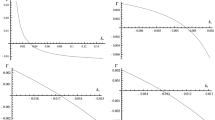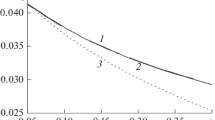Abstract
The process of origination and development of instabilities of the longitudinal waves of two types, namely, low-frequency ion-acoustic and high-frequency (“electronic”) Langmuir waves, in the preflare atmosphere of an active solar region are studied. The area under study is located at the chromospheric part of the flare loop near its footpoint. A weak large-scale electric field of flaring loop is the main source of these instabilities. The velocity of an electronic flow in the preflare plasma is supposed to be much lower than thermal electron velocity. Instability development is considered against the background of small-scale Bernstein wave turbulence, which exists in the preflare plasma and has an extremely low threshold of excitation. The necessary conditions for the instability origination and development, as well as the boundary values of the main plasma and wave perturbation parameters, are calculated.
Similar content being viewed by others
References
A. F. Aleksandrov, L. S. Bogdankevich, and A. A. Rukhadze, Plasma Hydrodynamics Foundations (Vysshaya shkola, Moscow, 1989) [in Russian].
A. T. Altyntsev, V. G. Banin, G. V. Kuklin, and V. M. Tomozov, Solar Bursts (Nauka, Moscow, 1982) [in Russian].
G. Grim, Broadening of Spectral Lines in Plasma (Mir, Moscow, 1978) [in Russian].
V. V. Zaitsev, A. P. Stepanov, and Yu. T. Tsap, “Some problems of solar and star flare physics,” Kinematika Fiz. Nebesnykh Tel 10(6), 3–31 (1994).
A. N. Krishtal’, S. V. Gerasimenko, and A. D. Voitsekhovskaya, “To the question of possibility of appearance of preflare current sheathes in the chromosphere of an active solar region,” Kosm. Nauka Tekhnol. 18(3), 52–60 (2012).
A. N. Krishtal’, S. V. Gerasimenko, A. D. Voitsekhovskaya, and A. A. Solov’ev, “To the question of a possibility of development of Langmuir turbulence development during the early stage of a flare process,” Kosm. Nauka Tekhnol. 15(5), 59–67 (2009).
V. E. Reznikova, V. F. Mel’nikov, S. P. Gorbikov, and K. Shibasaki, “Dynamics of radio brightness distribution along a flaring loop,” in Abstracts of the Conf. “Plasma Physics in the Solar System”, Moscow, SPI RAS, February 5–8, 2008 (SRI RAS, Moscow, 2008), p. 17 [in Russian].
B. V. Somov, V. S. Titov, and A. I. Vernetta, “Magnetic reconnection in solar flares,” in Science and Engineering Results Summary, Available from VINITI. Astronomiya 34, 136–237 (1987) [in Russian].
Yu. E. Charikov, “Preflare stage of energy accumulation: New observations and possible mechanisms,” in Abstracts of the 11th Pulkovo Intern. Conf. on Solar Physics, MAO RAS, Pulkovo, St. Petersburg, July 2–7, 2007 (St. Petersburg, 2007), pp. 138–139 [in Russian].
F. F. Chen, Introduction to Plasma Physics and Controlled Fusion (Plenum, New York, 1984).
O. A. Sheiner and V. M. Fridman, “Microwave radiation structure in view of the plasma diagnostics in the solar atmosphere,” in Abstracts of the Conf. “Plasma Physics in the Solar System”, Moscow, SPI RAS, February 5–8, 2008 (SRI RAS, Moscow, 2008), p. 10 [in Russian].
M. I. Aschwanden, “An evaluation of coronal heating models for active regions based on Yohkoh, SOHO and TRACE observations,” Astrophys. J. 560, 1035–1043 (2001).
J. M. Fontenla, E. H. Avrett, and R. Loeser, “Energy balance in solar transition region. III. Helium emission in hydrostatic, constant-abundance models with diffusion,” Astrophys. J. 406(1), 327–336 (1993).
P. Foukal and S. Hinata, “Electric fields in the solar atmosphere: A review,” Solar Phys. 132(2), 307–334 (1991).
A. A. Galeev, D. Lominadze, A. Pataria, et al., “Anomalous resistance of plasma due to the instability of the cyclotron harmonics,” Zh. Eksp. Teor. Fiz., 417–420 (1972).
A. A. Galeev and R. Z. Sagdeev, “Nonlinear plasma theory,” Probl. Plasma Theory 7, 3–48 (1973).
A. A. Galeev and R. Z. Sagdeev, “Current instabilities and anomalous resistance of plasma,” in Handbook of Plasma Physics. Basic Plasma Physics, Ed. by A. A. Galeev and R. N. Sudan (Amsterdam, 1984), Vol. 2, pp. 272–303.
J. Heyvaerts, E. R. Priest, and D. M. Rust, “Models of solar flares,” Astrophys. J. 216, 213–221 (1977).
A. N. Kryshtal, “Bernstein wave instability in a collisional plasma with a quasistatic electric field,” J. Plas. Phys. 60(3), 469–484 (1998).
A. N. Kryshtal, S. V. Gerasimenko, and A. D. Voitsekhovska, ““Oblique” Bernstein modes in solar preflare plasma: Generation of second harmonics,” Adv. Space Res. 49, 791–796 (2012).
A. N. Kryshtal and V. P. Kucherenko, “A possible excitation mechanism for a longitudinal wave instability in a plasma by a quasi-static electric field,” J. Plasma. Phys 53(2), 169–183 (1995).
A. N. Kryshtal and V. P. Kucherenko, “Ion-acoustic instability caused by large-scale electric field in solar active regions,” Solar Phys. 165(1), 139–153 (1996).
M. E. Machado, E. H. Evrett, J. E. Vernazza, and R. W. Noyes, “Semiempirical models of chromospheric flare regions,” Astrophys. J. 242(1), 336–351 (1980).
V. F. Melnikov, K. Shibasaki, and V. E. Reznikova, “Loop-top nonthermal microwave source in extended solar flaring loops,” Astrophys. J. 580, L185–L188 (2002).
I. A. Miller, P. I. Cargil, A. G. Emslie, et al., “Critical issues for understanding particle acceleration in impulsive solar flares,” J. Geophys. Res. 102(A7), 14631–14659 (1997).
D. Pines and J. R. Schrieffer, “Collective behavior in solid-state plasmas,” Phys. Rev. 124(5), 1387–1400 (1961).
S. K. Solanki, “Small-scale solar magnetic fields: An overview,” Space Sci. Revs. 63, 1–183 (1993).
J. E. Vernazza, E. H. Avrett, and R. Loeser, “Structure of the solar chromosphere. III. Models of the EUV brightness components of the quiet-sun,” Astrophys. J., Suppl. Ser. 45(1), 635–725 (1981).
Author information
Authors and Affiliations
Corresponding author
Additional information
Original Russian Text © A.N. Kryshtal, A.D. Voitsekhovska, S.V. Gerasimenko, M.V. Sidorenko, 2014, published in Kinematika i Fizika Nebesnykh Tel, 2014, Vol. 30, No. 5, pp. 39–55.
About this article
Cite this article
Kryshtal, A.N., Voitsekhovska, A.D., Gerasimenko, S.V. et al. On the possibility of the development of longitudinal wave instabilities on the background of the small-scale Bernstein turbulence in preflare chromosphere of a solar active region. Kinemat. Phys. Celest. Bodies 30, 234–243 (2014). https://doi.org/10.3103/S0884591314050043
Received:
Published:
Issue Date:
DOI: https://doi.org/10.3103/S0884591314050043




